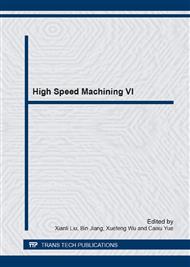p.20
p.26
p.32
p.37
p.42
p.48
p.53
p.61
p.66
Investigation of Cutting Force and Tool Wear in High Speed Milling of GH4169 Using Ceramic Tools
Abstract:
Experiments were carried out to investigate the cutting force and tool wear behavior of Sialon ceramic tools in high speed milling of GH4169 under different cutting parameters. The cutting speed exhibited the most significant influence on the cutting force. The cutting force decreased firstly then increased with the increasing of cutting speed. And the effect of feed speed and cutting depth on cutting force were also discussed. The worn surfaces of tool were examined and the elements on the tool surfaces were analyzed by employing scanning electron microscopy (SEM) and energy dispersive X-ray spectroscopy (EDS), respectively. The analysis results of the SEM and EDS showed that the dominant wear pattern were rake face flaking and notching at the low cutting speed while flank wear was the main wear type at the high cutting speed of 1037m/min.
Info:
Periodical:
Pages:
42-47
Citation:
Online since:
July 2014
Authors:
Keywords:
Price:
Сopyright:
© 2014 Trans Tech Publications Ltd. All Rights Reserved
Share:
Citation:


